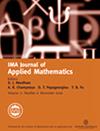耦合Cahn–Hilliard方程中的局部化态
IF 1.2
4区 数学
Q2 MATHEMATICS, APPLIED
引用次数: 14
摘要
经典的Cahn–Hilliard(CH)方程对应于描述二元混合物中相分解的梯度动力学模型。在旋节区,最初的均匀状态通过大规模的不稳定性自发分解为典型结构长度的液滴、空穴或迷宫式的浓度模式,随后是持续的粗化过程。在这里,我们考虑了两个浓度场的耦合CH动力学,并表明非互易(或主动或非变分)耦合可能导致小规模(图灵)不稳定性。在相应的主分叉处,出现了一个周期性模式稳态的分支。此外,存在由与均匀背景共存的图案化斑块组成的局部状态。稳态宇称对称和宇称非对称定域态的分支形成了具有守恒定律的系统典型的倾斜同宿蛇形结构。与具有梯度动力学的系统中的蛇形结构相反,在这里,Hopf不稳定性发生在足够大的活动下,这导致振荡和行进的局域模式。本文章由计算机程序翻译,如有差异,请以英文原文为准。
Localized states in coupled Cahn–Hilliard equations
The classical Cahn–Hilliard (CH) equation corresponds to a gradient dynamics model that describes phase decomposition in a binary mixture. In the spinodal region, an initially homogeneous state spontaneously decomposes via a large-scale instability into drop, hole or labyrinthine concentration patterns of a typical structure length followed by a continuously ongoing coarsening process. Here, we consider the coupled CH dynamics of two concentration fields and show that non-reciprocal (or active or non-variational) coupling may induce a small-scale (Turing) instability. At the corresponding primary bifurcation, a branch of periodically patterned steady states emerges. Furthermore, there exist localized states that consist of patterned patches coexisting with a homogeneous background. The branches of steady parity-symmetric and parity-asymmetric localized states form a slanted homoclinic snaking structure typical for systems with a conservation law. In contrast to snaking structures in systems with gradient dynamics, here, Hopf instabilities occur at a sufficiently large activity, which results in oscillating and travelling localized patterns.
求助全文
通过发布文献求助,成功后即可免费获取论文全文。
去求助
来源期刊
CiteScore
2.30
自引率
8.30%
发文量
32
审稿时长
24 months
期刊介绍:
The IMA Journal of Applied Mathematics is a direct successor of the Journal of the Institute of Mathematics and its Applications which was started in 1965. It is an interdisciplinary journal that publishes research on mathematics arising in the physical sciences and engineering as well as suitable articles in the life sciences, social sciences, and finance. Submissions should address interesting and challenging mathematical problems arising in applications. A good balance between the development of the application(s) and the analysis is expected. Papers that either use established methods to address solved problems or that present analysis in the absence of applications will not be considered.
The journal welcomes submissions in many research areas. Examples are: continuum mechanics materials science and elasticity, including boundary layer theory, combustion, complex flows and soft matter, electrohydrodynamics and magnetohydrodynamics, geophysical flows, granular flows, interfacial and free surface flows, vortex dynamics; elasticity theory; linear and nonlinear wave propagation, nonlinear optics and photonics; inverse problems; applied dynamical systems and nonlinear systems; mathematical physics; stochastic differential equations and stochastic dynamics; network science; industrial applications.

 求助内容:
求助内容: 应助结果提醒方式:
应助结果提醒方式:


